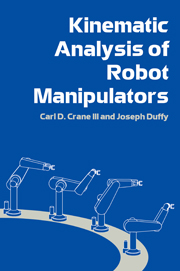Book contents
- Frontmatter
- Contents
- Preface
- 1 Introduction
- 2 Coordinate transformations
- 3 Manipulator kinematics
- 4 Forward kinematic analysis
- 5 Reverse kinematic analysis problem statement
- 6 Spherical closed-loop mechanisms
- 7 Displacement analysis of group 1 spatial mechanisms
- 8 Group 2 spatial mechanisms
- 9 Group 3 spatial mechanisms
- 10 Group 4 spatial mechanisms
- 11 Case studies
- 12 Quaternions
- Appendix
- References
- Index
6 - Spherical closed-loop mechanisms
Published online by Cambridge University Press: 12 September 2009
- Frontmatter
- Contents
- Preface
- 1 Introduction
- 2 Coordinate transformations
- 3 Manipulator kinematics
- 4 Forward kinematic analysis
- 5 Reverse kinematic analysis problem statement
- 6 Spherical closed-loop mechanisms
- 7 Displacement analysis of group 1 spatial mechanisms
- 8 Group 2 spatial mechanisms
- 9 Group 3 spatial mechanisms
- 10 Group 4 spatial mechanisms
- 11 Case studies
- 12 Quaternions
- Appendix
- References
- Index
Summary
Equivalent closed-loop spherical mechanism
In the previous chapter, it was shown that any serial manipulator can be transformed into a closed-loop spatial mechanism by constructing a hypothetical closure link. This chapter will focus on the geometry of the new closed-loop mechanism.
A new closed-loop mechanism called the equivalent spherical mechanism will be formed from the original spatial closed-loop mechanism. The first step in creating the equivalent spherical mechanism is to give all the unit joint vectors, Si, which label revolute or cylindric joint axes, self-parallel translations so that they all meet in a common point O and so that they all point outward from O (see Figure 6.1). Thus the directions of the Si vectors are the same for the original spatial mechanism and the cointersecting arrangement.
Consider now that a unit sphere is drawn, centered at point O. The unit vectors Si will meet this sphere at a sequence of points, i = 1, 2, 3,…, and so forth, as shown in Figure 6.2. Links (arcs of great circles) can be drawn on the unit sphere joining adjacent points, 12, 23, 34,…, and so forth. For example, Figure 6.2 illustrates a spherical link joining points 1 and 2 such that the angle between S1 and S2 is α12, that is, the same angle as between S1 and S2 in the original spatial mechanism.
Information
- Type
- Chapter
- Information
- Kinematic Analysis of Robot Manipulators , pp. 53 - 91Publisher: Cambridge University PressPrint publication year: 1998
